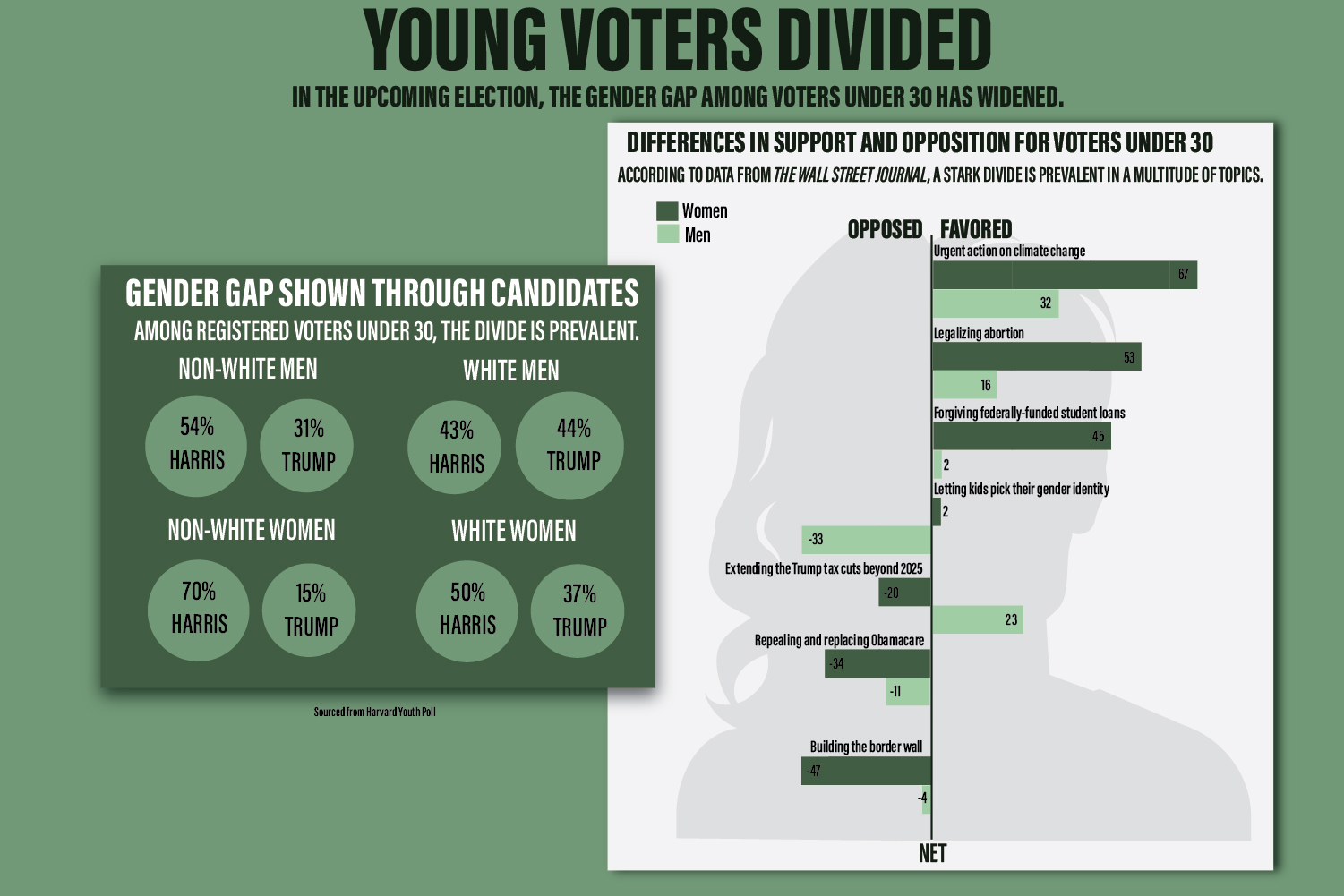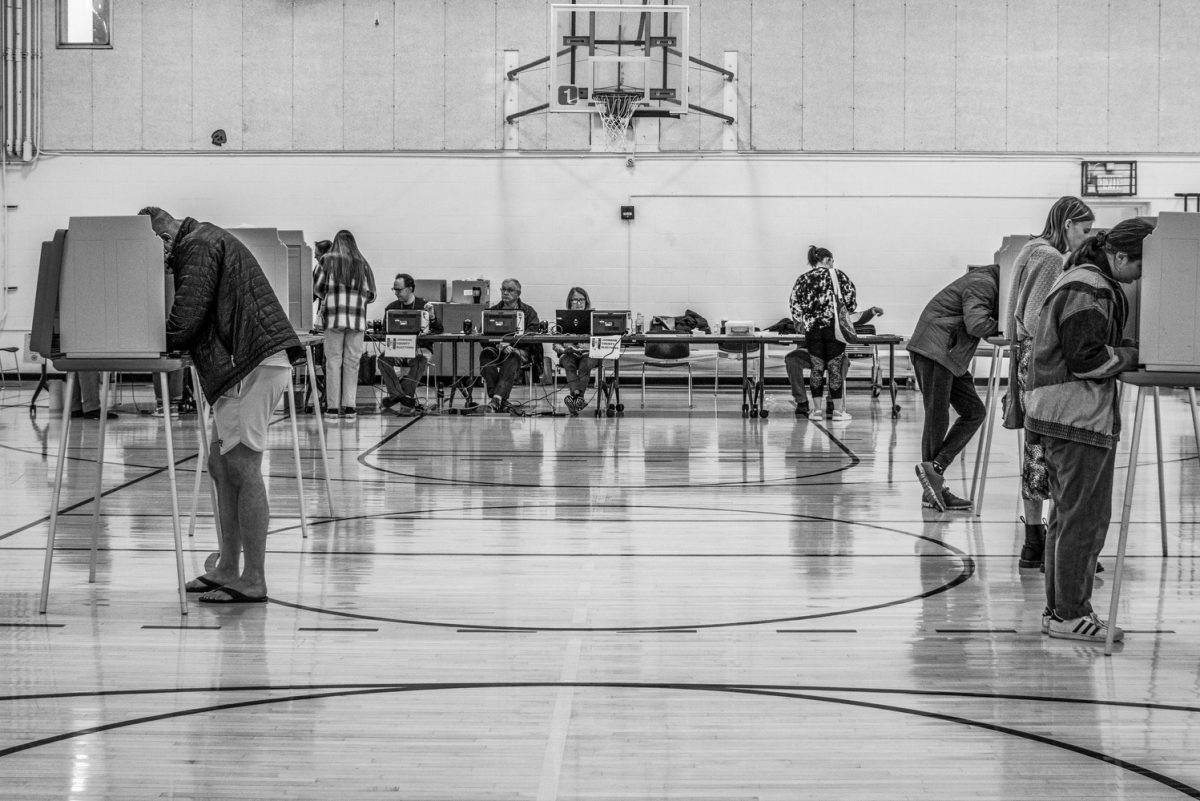Rita McCarthy is voting for Vice President Kamala Harris because she is worried about losing individual rights and freedom in America.
“There’s a lot at stake for women,” she said.
Caleb Killing-Matthews plans to vote for former President Donald Trump, partially because he disagrees with the social stances of more progressive candidates.
“They’re forgetting the rest of the population,” he said.
Both McCarthy and Killing-Matthews are current students at the University of Iowa, learning to navigate an increasingly polarized political climate that has pitted young men against women. As a hotbed for political activity, college campuses across the U.S. showcase this gender divide in political ideology.
Historically, voters under 30 have been a solid voting block for the Democratic Party. In 2020, almost 60 percent of voters aged 18 to 29 cast ballots for President Joe Biden, according to Pew Research Center.
Recent data, however, suggests the tides have shifted. Polls from The Wall Street Journal show a majority of men under 30 prefer Trump to Harris in office. Women under 30 have only shifted farther to the left, with data from the Harvard Youth Poll showing 50 percent of white women and 70 percent of non-white women preferring Harris as the next president.

Divisive political topics
The existence of a gender divide in American politics is not necessarily new, Karen Kedrowski, the director of the Iowa State University Carrie Chapman Catt Center for Women and Politics said. Kedrowski said women have historically voted for Democratic candidates.
“What’s different about this year is the size of the gender gap, especially among young voters,” she said.
Kedrowski said the overturning of Roe v. Wade is one of the main drivers in this fractured political climate.
She said while men might feel empathetic regarding the overturning of Roe v. Wade, they are not as directly impacted by abortion bans and restrictions cropping up across the country.
“It might be an issue that interests men, but it’s more abstract,” Kedrowski said.
McCarthy said while she was less politically active in 2016, she remembers being “upset and scared” by how former President Trump’s choices would impact marginalized people in the U.S.
“Going through it all over again and having your rights at stake again,” McCarthy said. “It kind of feels more extreme this time.”
For Killing-Matthews, however, that emphasis on women’s rights is what is turning off some young voters.
He said rather than observing more social issues like abortion and LGBTQ+ freedoms, he wants candidates to have tangible plans for the economy and immigration.
“I think that they’re starting to lose us because they’re no longer concerned with our concerns,” Killing-Matthews said.
Kedrowski also pointed to the different versions of masculinity presented by the respective presidential tickets as a manifestation of this divide.
“For voters for whom a particular type of masculinity is important — you know, the sort of ‘Hulk Hogan rip your shirt off’ kind of masculinity — they are going to be really attracted by the more aggressive displays,” she said, referencing wrestler Hogan’s 2024 Republican National Convention speech which Hogan ripped off his shirt with his bare hands partway through.
RELATED: As political tensions flare on immigration, voters pin it as a top issue
Kedrowski said while these displays may be empowering and motivating to men, there are generally turn-offs for women.
In turn, Kedrowski said Minnesota Gov. and vice presidential candidate Tim Walz presents an alternative to the hypermasculinity seen in former President Trump’s campaign strategy.
Walz has embraced the masculine elements of his Midwestern roots — being a hunter, a member of the National Guard, and a former high school football coach — while also stressing the importance of joy and care for people. Kedrowski said, for women, this manifestation of masculinity is more persuasive.
“The masculinity demonstrated by Governor Walz, I think, would be more attractive simply because it’s just not as aggressive and is not rooted in violence,” Kedrowski said.
Voter turnout and civic participation
With a tight race between Harris and Trump — who are neck and neck in essential swing states when looking at aggregated data from The New York Times — young voters could tip the scales of the electoral college.
According to Politico, young people are a large reason why Georgia, traditionally a deep red state, flipped blue in 2020. Biden’s win in Georgia was due to a group of activists in the state mobilizing first-time voters who were predominantly young people of color to vote for Biden. Eeking out a razor-thin majority with just 49.5 percent of the vote for Biden, these efforts in Georgia were years in the making.
While the gendered gap in voting preferences has skyrocketed, the actual voting results may not be as stark come November. While more young men prefer Trump to Harris in the upcoming election, these supporters are less likely to visit the polls and vote, according to the Harvard Youth Poll.
Hawk the Vote, a nonpartisan organization at Iowa focused on driving student civic engagement, has held several events engaging with potential student voters across Iowa City. Through these efforts, students involved with Hawk the Vote have been allocated a firsthand look at the current political climate at the University of Iowa.
“The university very much feels like a microcosm of greater society,” Jaden Bartlett, the executive director of Hawk the Vote, said. “Every aspect of the larger world is represented here on a smaller level.”
Christine Valora, the communications director for Hawk the Vote, said around two-thirds of students registered in a course collaborating with the organization to bolster political engagement on campus are women.
“That might not necessarily be who’s voting, but it’s who’s politically attuned,” Valora said.
While Valora and Bartlett have observed topics that both conservative and progressive students have some unity on — including a need for third spaces that exist outside of work and home — social topics such as abortion have fragmented young voters.
“It’s fear, and on both ends,” Valora said.
This fear could manifest in more people showing up to the polls, Valora and Bartlett said.
“It’s a double-edged sword,” Bartlett said. “We don’t love polarization, but at the same time, the more that you see another group as a sort of enemy, the more charged you’re going to be to take action.”
Editor’s note: Christine Valora is a former staff member at The Daily Iowan.



